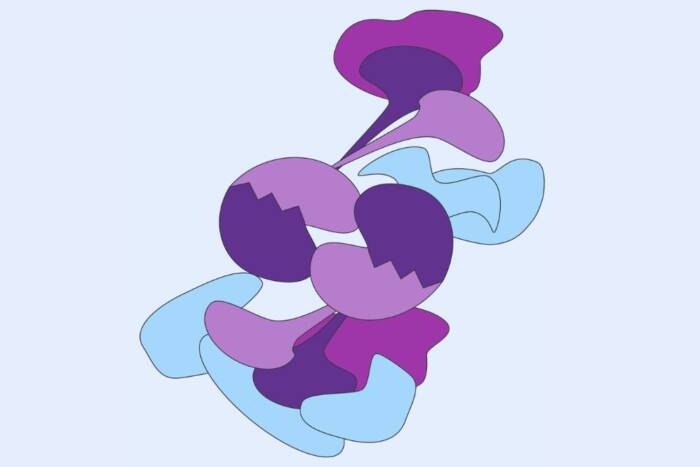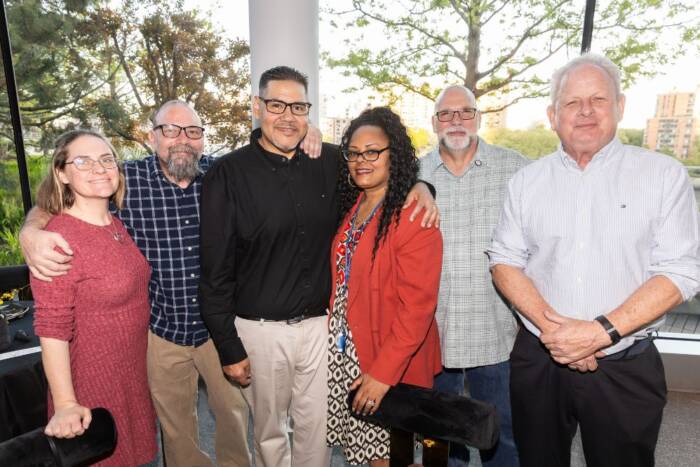More Than Just Packaging, Histones Help Turn Genes On

Rockefeller researchers have developed one of the first successful test tube systems for studying the effects of DNA packaging proteins called histones on gene activity. Above: reconstituted "chromatin" containing genetically altered histones and DNA. The new chromatin system led the researchers to the surprising finding that the “tails” of histones are essential to switching genes on. In addition, the system will allow scientists to explore the possibility of a “histone code” — an emerging theory stating that varying patterns of chemical tags along histone tails control which genes become activated, and which remain silent.
Rockefeller scientists redefine role of proteins responsible for bundling DNA into cells
Histones, the proteins that help roll several feet of DNA into the microscopic span of a single nucleus, are turning out to be much more than just packaging material. Instead, recent studies indicate that these once underrated proteins actively participate in switching genes “on” — a vital life process occurring at all times in each one of our cells.
Now, new research at The Rockefeller University shows that the dangling ends or “tails” of histones are less passive than previously believed. In fact, the researchers say these tails act more like “arms” to directly affect gene activity once the DNA is unpackaged.
The findings, reported in the April issue of Molecular Cell, not only provide fundamental insight into the complex workings of the human cell, but also may one day lead to new treatments for diseases in which genes have been improperly turned on or off, such as cancer. Furthermore, this kind of knowledge may provide new strategies for combating the handful of developmental disorders associated with malfunctioning histones, such as Rubinstein-Taybi syndrome and Coffin-Lowry syndrome.
“We found that if we removed the tails from histones, genes could not be activated,” says Woojin An, Ph.D., a postdoctoral fellow at Rockefeller and first author of the new research paper. “Because these tails are essential to switching genes on, they are really more like arms.”
In addition to this unexpected finding, the researchers also have developed a powerful new biochemical tool for deciphering a possible “histone code.” According to this emerging theory, histone tails are coded or patterned with varying combinations of chemical tags that ultimately dictate which genes get switched on, and which remain silent.
“If there is some form of histone code, then this new system could potentially enable scientists to interpret it,” says Robert G. Roeder, head of the Laboratory of Biochemistry and Molecular Biology at Rockefeller and principal author of the report.
Moreover, knowledge of such a code would allow scientists to manipulate it for the treatment of diseases in which gene production has gone awry.
Histones help to package DNA, the hereditary material of life, into each cell’s nucleus. The double-helical strand of DNA wraps around a ball of histones consisting of four distinct proteins: H2A, H2B, H3 and H4. This fundamental unit, called a nucleosome, is repeated at regular intervals throughout the length of DNA and, under a microscope, resembles “beads on a string.” Compact strings of nucleosomes coil up further to form chromatin and even further to become the familiar X-shaped chromosomes of human cells.
Hidden within this bundled mass of histones and DNA are the genes: the cell’s instructions for manufacturing its tens of thousands of proteins. Therefore, before the cell’s machinery can “read” or, as scientists say, “transcribe” these genetic instructions and ultimately produce a protein of interest, it must somehow open up or unfold the tightly wound chromatin.

- Researchers in the laboratory of Robert G. Roeder, including Vikas B. Palhan (left) and first author Woojin An, report that the “tails” of histones, previously thought to play only a passive role in repressing gene activity, in fact act more like arms to switch genes on once the DNA is unpackaged.
But just how the cell’s machinery knows which stretches of chromatin to break open and read, and which to keep silent, remains poorly understood.
Some scientists think that the key to regulating the activity of genes may lie with the very proteins that package them. They propose that the tails of each histone become coded with different patterns of chemical tags and thus, like a combination lock guarding a safe full of genes, only permit access to those gene-reading machines that somehow “know” the right “histone code.” This code is not inherent to the histones themselves but is generated by other proteins in the nucleus.
Now, as a twist to this developing story, Roeder and collegues have discovered an entirely novel function for tails. They show that these dangling ends, in addition to repressing genes through chromatin folding, also play an active role in switching genes on once the folding is reversed.
“As counterintuitive as it may seem, these tails seem to act both to block and to activate gene transcription,” says Roeder.
Previously scientists thought that the tails — which unlike the rest of the histone extend from the compact body of the core nucleosome — blocked transcription of a gene by causing chromatin folding. Gene activation was thought to occur after the inhibitory effects of the tails were neutralized by the addition of a chemical tag — a process called acetylation.
“Histone tails are covered with positive charges and are therefore attracted to the negatively charged DNA,” says An. “Scientists believed that acetylation, by masking the positive charges on tails, caused the chromatin and underlying DNA to become less constricted by the histones and thus more receptive to unfolding.”
To test this theory, the researchers recreated coiled up chromatin in a test tube using engineered or recombinant histones and DNA — a feat in itself considering that this type of biochemical tool had never before been successfully implemented. They also showed that by adding a specific gene activator protein and a “coactivator” protein called p300 they could coax the chromatin to open up and permit transcription of a target gene.
Both a gene activator and a coactivator are required to switch on a target gene. First the activator binds to a specific sequence of DNA in front of the target gene; next the coactivator binds to the activator and allows it to communicate with the gene-reading or transcription machinery, and finally transcription begins. Importantly, p300, in addition to its role as a mediator, enhances transcription via acetylation of histone tails.
Next, the researchers repeated the chromatin assembly experiment with recombinant histones lacking tails. Because the prevailing theory at the time stated that the physical presence of histone tails acts mainly to prevent transcription of a target gene, they predicted that the tailless histones would render chromatin unable to fold and automatically lead to gene activation. But, to their surprise, the exact opposite was true: the chromatin, though unfolded, remained silent and unfit for gene transcription.
“Something else must be repressing transcription of genes besides the tails,” says An. “And this must be the residual nucleosome core structure.”
“In addition,” he says, “this data tell us that the tails are required for transcription, a surprising finding really when you consider that for several decades, these protein tails were thought to be mainly involved in repressing genes.”
The researchers then asked how acetylation of histone tails fits into their new model. If this process of chemical tagging does not simply modify the tails to enable chromatin unfolding, they wondered, then what is its role? To address this question, they again assembled chromatin in a test tube; only this time they used histones with tails genetically altered to make acetylation by p300 impossible. Once more, the researchers found that the target gene could not be activated, thereby demonstrating not only that histone tails are required for turning genes on, but, more specifically, that acetylated histone tails are required.
Finally, taking this experiment one step further, the researchers showed that p300 prefers to acetylate histone protein H3, with its next choice being H4. In addition, they found that only a few of the possible acetylation sites on histone tails H3 and H4 seem to be essential for gene activation.
John D. Rockefeller founded Rockefeller University in 1901 as The Rockefeller Institute for Medical Research. Rockefeller scientists have made significant achievements, including the discovery that DNA is the carrier of genetic information. The University has ties to 21 Nobel laureates, six of which are on campus. Rockefeller University scientists have received this award for two consecutive years: neurobiologist Paul Greengard, Ph.D., in 2000 and cell biologist Günter Blobel, M.D., Ph.D., in 1999, both in Physiology or Medicine. At present, 33 faculty are elected members of the U.S. National Academy of Sciences. Celebrating its Centennial anniversary in 2001, Rockefeller – the nation’s first biomedical research center – continues to lead the field in both scientific inquiry and the development of tomorrow’s scientists.


